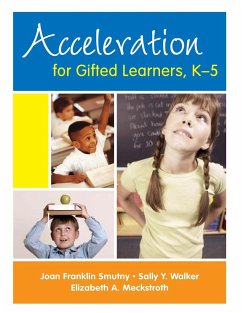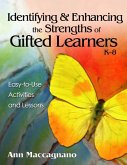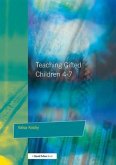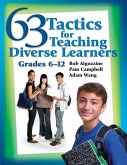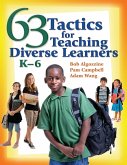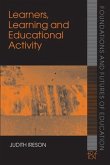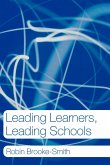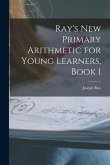- Broschiertes Buch
- Merkliste
- Auf die Merkliste
- Bewerten Bewerten
- Teilen
- Produkt teilen
- Produkterinnerung
- Produkterinnerung
This valuable book dispels common myths about acceleration, reviews social/emotional considerations, and provides tools for effectively determining the most appropriate learning options for gifted students.
Andere Kunden interessierten sich auch für
![Identifying and Enhancing the Strengths of Gifted Learners, K-8 Identifying and Enhancing the Strengths of Gifted Learners, K-8]() Ann MaccagnanoIdentifying and Enhancing the Strengths of Gifted Learners, K-840,99 €
Ann MaccagnanoIdentifying and Enhancing the Strengths of Gifted Learners, K-840,99 €![Teaching Gifted Children 4-7 Teaching Gifted Children 4-7]() Valsa KoshyTeaching Gifted Children 4-756,99 €
Valsa KoshyTeaching Gifted Children 4-756,99 €![63 Tactics for Teaching Diverse Learners, Grades 6-12 63 Tactics for Teaching Diverse Learners, Grades 6-12]() Bob Algozzine63 Tactics for Teaching Diverse Learners, Grades 6-1242,99 €
Bob Algozzine63 Tactics for Teaching Diverse Learners, Grades 6-1242,99 €![63 Tactics for Teaching Diverse Learners, K-6 63 Tactics for Teaching Diverse Learners, K-6]() Bob Algozzine63 Tactics for Teaching Diverse Learners, K-640,99 €
Bob Algozzine63 Tactics for Teaching Diverse Learners, K-640,99 €![Learners, Learning and Educational Activity Learners, Learning and Educational Activity]() Judith IresonLearners, Learning and Educational Activity65,99 €
Judith IresonLearners, Learning and Educational Activity65,99 €![Leading Learners, Leading Schools Leading Learners, Leading Schools]() Robin Brooke-SmithLeading Learners, Leading Schools36,99 €
Robin Brooke-SmithLeading Learners, Leading Schools36,99 €![Ray's New Primary Arithmetic for Young Learners, Book 1 Ray's New Primary Arithmetic for Young Learners, Book 1]() Joseph RayRay's New Primary Arithmetic for Young Learners, Book 119,99 €
Joseph RayRay's New Primary Arithmetic for Young Learners, Book 119,99 €-
-
-
This valuable book dispels common myths about acceleration, reviews social/emotional considerations, and provides tools for effectively determining the most appropriate learning options for gifted students.
Hinweis: Dieser Artikel kann nur an eine deutsche Lieferadresse ausgeliefert werden.
Hinweis: Dieser Artikel kann nur an eine deutsche Lieferadresse ausgeliefert werden.
Produktdetails
- Produktdetails
- Verlag: Corwin
- Seitenzahl: 232
- Erscheinungstermin: 19. Oktober 2006
- Englisch
- Abmessung: 280mm x 216mm x 13mm
- Gewicht: 595g
- ISBN-13: 9781412925679
- ISBN-10: 1412925673
- Artikelnr.: 21083988
- Herstellerkennzeichnung
- Libri GmbH
- Europaallee 1
- 36244 Bad Hersfeld
- gpsr@libri.de
- Verlag: Corwin
- Seitenzahl: 232
- Erscheinungstermin: 19. Oktober 2006
- Englisch
- Abmessung: 280mm x 216mm x 13mm
- Gewicht: 595g
- ISBN-13: 9781412925679
- ISBN-10: 1412925673
- Artikelnr.: 21083988
- Herstellerkennzeichnung
- Libri GmbH
- Europaallee 1
- 36244 Bad Hersfeld
- gpsr@libri.de
Joan Franklin Smutny is founder and director of the Center for Gifted, a Northern Illinois University Partner. She directs programs for thousands of bright, talented, and gifted children in the Chicago area annually. She also teaches creative writing in many of these programs as well as courses on gifted education for graduate students at the university level. She is editor of the Illinois Association for Gifted Children Journal, contributing editor of Understanding Our Gifted, and a regular contributor to the Gifted Education Communicator, Parenting for High Potential, and the Gifted Education Press Quarterly. Smutny has authored, co-authored, and edited many articles and books on gifted education for teachers, parents, and administrators, including Challenging High Potential Spanish Speaking Students (2012), Teaching Advanced Learners in the General Education Classroom (2011), Manifesto of the Gifted Girl (2010), Differentiating for the Young Child, Second Edition (2010), Igniting Creativity in Gifted Learners, K-6 (2009), Acceleration for Gifted Learners, K-5 (2007), Reclaiming the Lives of Gifted Girls and Women (2007), Designing and Developing Programs for Gifted Students (2003), Underserved Gifted Populations (2003), Gifted Education: Promising Practices (2003), Stand Up for Your Gifted Child (2001), The Young Gifted Child: Potential and Promise, an Anthology (1998), and Teaching Young Gifted Children in the Regular Classroom (1997). In 1996, she won the National Association for Gifted Children (NAGC) Distinguished Service Award for outstanding contribution to the field of gifted education.
Preface
Acknowledgements
About the Authors
Introduction
Part I: Acceleration: Issues and Applications for Gifted Learners (K-5)
1. Acceleration and the K-5 Gifted Child
2. Acceleration in a Differentiated Classroom
3. Acceleration and Creativity: Closing the Gap
4. Assessment for Accelerated Learners
Part II: Appropriate Academic-Classroom Acceleration
5. Acceleration of Content
6. The Thinking Process
7. Product Development
8. Standards and Policy
Part III: Social and Emotional Aspects of Effective Acceleration
9. Obstacles to Acceleration
10. Adaptations to Personality
11. Facilitating Acceleration
12. Social Relationships
13. Facilitating Acceleration for Parents and Educators
References
Index
Acknowledgements
About the Authors
Introduction
Part I: Acceleration: Issues and Applications for Gifted Learners (K-5)
1. Acceleration and the K-5 Gifted Child
2. Acceleration in a Differentiated Classroom
3. Acceleration and Creativity: Closing the Gap
4. Assessment for Accelerated Learners
Part II: Appropriate Academic-Classroom Acceleration
5. Acceleration of Content
6. The Thinking Process
7. Product Development
8. Standards and Policy
Part III: Social and Emotional Aspects of Effective Acceleration
9. Obstacles to Acceleration
10. Adaptations to Personality
11. Facilitating Acceleration
12. Social Relationships
13. Facilitating Acceleration for Parents and Educators
References
Index
Preface
Acknowledgements
About the Authors
Introduction
Part I: Acceleration: Issues and Applications for Gifted Learners (K-5)
1. Acceleration and the K-5 Gifted Child
2. Acceleration in a Differentiated Classroom
3. Acceleration and Creativity: Closing the Gap
4. Assessment for Accelerated Learners
Part II: Appropriate Academic-Classroom Acceleration
5. Acceleration of Content
6. The Thinking Process
7. Product Development
8. Standards and Policy
Part III: Social and Emotional Aspects of Effective Acceleration
9. Obstacles to Acceleration
10. Adaptations to Personality
11. Facilitating Acceleration
12. Social Relationships
13. Facilitating Acceleration for Parents and Educators
References
Index
Acknowledgements
About the Authors
Introduction
Part I: Acceleration: Issues and Applications for Gifted Learners (K-5)
1. Acceleration and the K-5 Gifted Child
2. Acceleration in a Differentiated Classroom
3. Acceleration and Creativity: Closing the Gap
4. Assessment for Accelerated Learners
Part II: Appropriate Academic-Classroom Acceleration
5. Acceleration of Content
6. The Thinking Process
7. Product Development
8. Standards and Policy
Part III: Social and Emotional Aspects of Effective Acceleration
9. Obstacles to Acceleration
10. Adaptations to Personality
11. Facilitating Acceleration
12. Social Relationships
13. Facilitating Acceleration for Parents and Educators
References
Index

